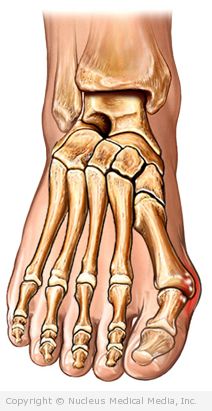(Hallux Valgus)
Bunion – Definition
A bunion is a thickened lump at the base of the big toe. It causes the big toe to move toward the smaller toes and makes walking difficult.
Bunion – Causes
Bunions are caused by a deformity of the metatarsophalangeal (MTP) joint at the base of the big toe. This causes instability of the joint.
Deformity can be caused by:
- Flat feet, which transfer too much weight to the MTP joint
- Narrow-toed shoes and high heels
- Certain neuromuscular diseases ( Down and Marfan syndromes)
- Activities that put undue stress on the feet, such as ballet
Bunion – Risk Factors
A risk factor is something that increases your chance of getting a disease or condition. Risk factors for a bunion include:
- Family members who have foot abnormalities
- Sex: female
- Diabetes
You should seek medical attention if you have diabetes and you are having problems with your feet.
Bunion – Symptoms
Symptoms include:
- Big toe that turns in toward the other toes (may overlap second or even third toe)
- Firm bump on the outside edge of the foot or at the base of the big toe
- Restricted or painful motion of the big toe
- Foot pain and stiffness
- Fluid-filled cyst between the skin and the bony lump
Bunion – Diagnosis
The doctor will examine your foot and ask about your symptoms. An x-ray of your foot will confirm that you have a bunion and show the extent of the damage.
Bunion – Treatment
The goals of treatment are to relieve pressure on the bunion and stop progression of the deformity.
Padding and Taping
Padding the bunion reduces pain and allows you to continue a normal, active life.
Taping helps to keep the foot in a normal position, reducing stress and pain.
Medication
- Anti-inflammatory drugs (ibuprofen, naproxen) to ease pain and inflammation
- Cortisone injections to ease pain and inflammation
Proper Footwear
Wear shoes that are wide and deep in the toe area. Make sure the top of the shoe doesn’t hit or rub against the bunion. There should be one-half inch of space between the shoe and the end of your longest toe when you are standing up.
Physical Therapy
Physical therapy can relieve inflammation and pain. Ultrasound therapy is often used for treating bunions and the related soft tissue problems.
Orthotics
Shoe inserts may be useful in maintaining foot function. They are thought to reduce symptoms and prevent worsening of the deformity.
Surgery
Surgery may be needed to relieve the pressure and repair the toe joint, if the other treatments fail. Surgical procedures include:
- Removal of the bony lump
- A more involved procedure that includes cutting the bone and realigning the joint
If you are diagnosed as having a bunion, follow your doctor’s instructions.
Bunion – Prevention
These tips can help to protect your feet and possibly reduce the risk of bunion:
- Wear wide toed shoes and comfortable footwear that does not pinch the toes.
- Avoid activities that cause foot pain, like standing too long.
- Prevent a minor bunion from worsening with bunion pads, and proper shoes.

